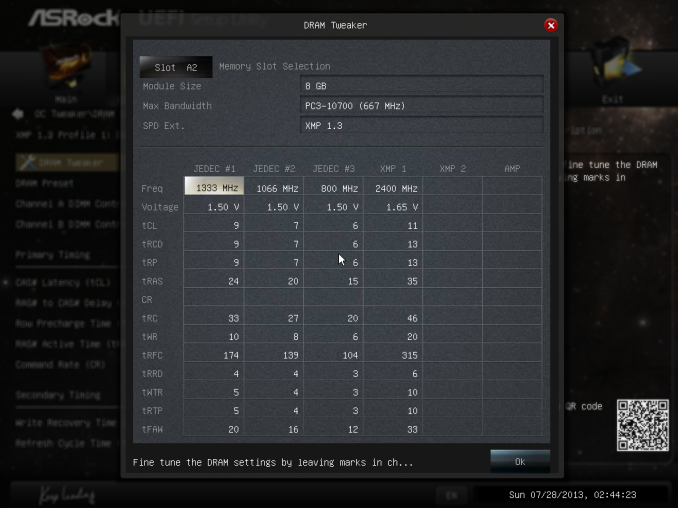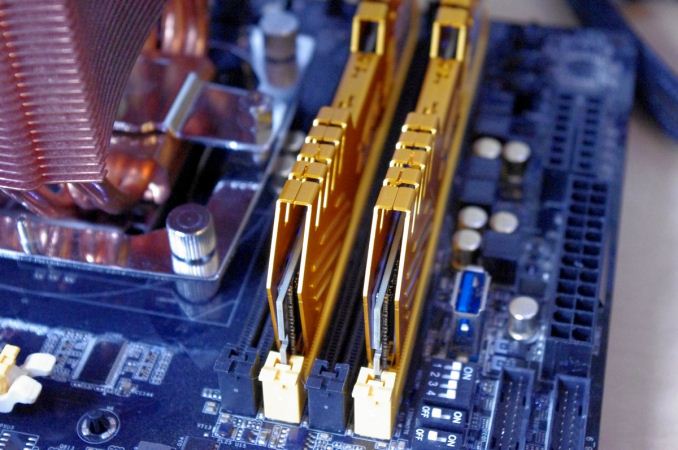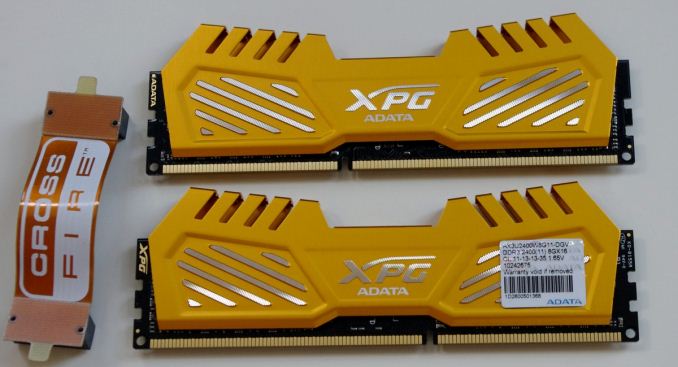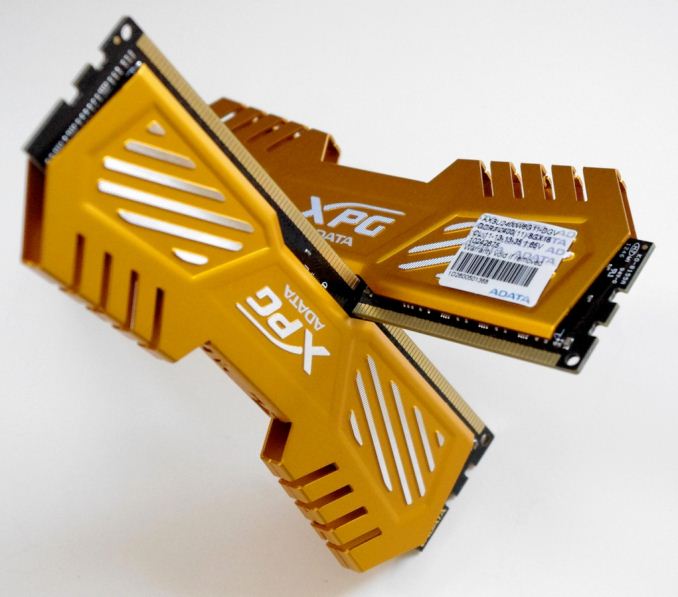
Original Link: https://www.anandtech.com/show/7495/adata-xpg-v2-review-2400-c11
ADATA XPG V2 Review: 2x8 GB at DDR3-2400 C11-13-13 1.65 V
by Ian Cutress on November 11, 2013 1:00 PM EST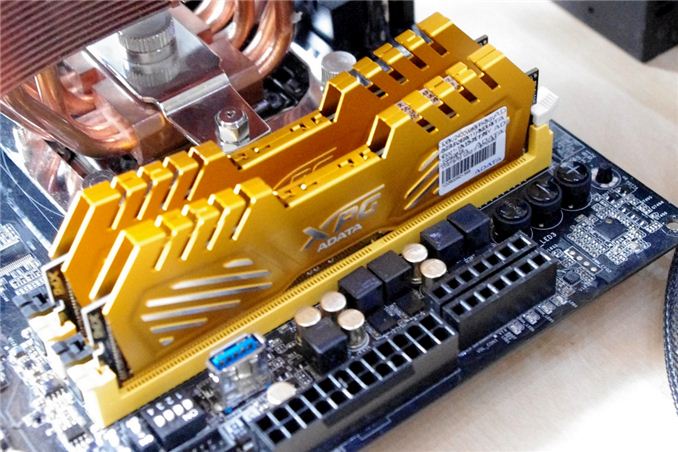
Memory has an odd part to play in the desktop ecosystem. There is plenty of it from many different manufacturers at various prices, speeds and benefits. Most of the differentiation comes around the product, such that two sets of 8GB DDR3-1600 might differ in warranty and aesthetics alone. With that in mind, we have several memory kits in the office tested, and the first one under analysis is a 2x8 GB DDR3-2400 C11 kit from ADATA’s XPG V2 line.
ADATA XPG V2 2x8GB DDR3-2400 C11 Overview
ADATA’s XPG (Extreme Performance Gear) V2 line is designed to showcase ADATA’s highest memory speed modules, although the range starts at 1600 C9 and extends to 3100 C12, with all speeds in 2x4 GB kits and 2x8 GB up to DDR3-2800. Each memory kit can be found in gold, as the kit today is, or in a tungsten grey. ADATA sent us several XPG V2 memory kits, such as this 2400 kit and a pair of 2800 kits to review.
The 2x8 2400 C11 kit sits in that spot around the sweet spot for memory tests: it escapes the basic failures that slow kits have, yet the specification precludes the price from spiraling out of control in terms of the memory MHz race that many manufacturers are keen to be a part of. While it is debatable if memory requires heatsinks, the gold colored ones on our XPG V2 aesthetically fit well with our ASRock Z87 OC Formula test bed and any similarly colored motherboard.
Overclocking performance at a boosted 1.72 volts gave a nice jump to 2666 11-13-13 stable, and a performance index of ~240 was applicable up to 2666 MHz from an original kit PI of 218. Out of the kits we have in to test, this was actually one of the better results by comparison.
The AX3U2400W8G11-DGV 2x8 GB kit currently retails at $200, or $12.50/GB. There are obviously cheaper kits available if you just need a 2x8GB kit without concern for the memory speed, but unfortunately for ADATA there are kits available at almost one third less, including their own tungsten grey versions at $140, which offers all the benefits just in a different color. As memory has a tendency to go up and down in pricing, it is often best to check on the day.
Specifications
Memory Specifications
| ADATA | ADATA | Corsair | Patriot | ADATA | G.Skill | |
| Name | - | AX3U2400W8G11-DGV | - | - | - | F3-3000C12D-8GTXDG |
| Speed | 1600 | 2400 | 2400 | 2400 | 2800 | 3000 |
| ST | 9-11-9-27 | 11-13-13-35 | 10-12-12-31 | 10-12-12-31 | 12-14-14-36 | 12-14-14-35 |
| Price | - | $200 | - | $92 | $316 | $520 |
| XMP | - | Yes | Yes | Yes | Yes | Yes |
| Size | 2 x 8GB | 2 x 8GB | 2 x 8GB | 2 x 4GB | 2 x 8GB | 2 x 4GB |
|
Performance Index |
178 | 218 | 240 | 240 | 233 | 250 |
|
|
||||||
| MHz | 1600 | 2400 | 2400 | 2400 | 2800 | 3000 |
| Voltage | 1.35 V | 1.65 V | 1.65 V | 1.65 V | 1.65 V | 1.65 V |
| tCL | 9 | 11 | 10 | 10 | 12 | 12 |
| tRD | 11 | 13 | 12 | 12 | 14 | 14 |
| tRP | 9 | 13 | 12 | 12 | 14 | 14 |
| tRAS | 27 | 35 | 31 | 31 | 36 | 31 |
| tRC | 46 | 49 | ||||
| tWR | 20 | 16 | ||||
| tRRD | 315 | 391 | ||||
| tRFC | 6 | 7 | ||||
| tWTR | 10 | 12 | ||||
| tRTP | 10 | 12 | ||||
| tFAW | 33 | 29 | ||||
| CR | 2 | 2 | ||||
As this is our first proper memory review on Haswell, we have tested some other kits which are going to be the focus of future reviews, and thus as comparison points we have listed them here to give a scale of comparison. Compared to the G.Skill DDR3-3000 12-14-14 kit that was the focus of the Haswell memory overview, the ADATA kit we are testing today seems to have looser tWR and tFAW timings.
Visual Inspection
Thankfully ADATA have avoided using annoying plastic packaging that can be a pain to get into – there is a simple tab on the back to help open their XPG V2 line of memory. The packaging is simple enough, just a thin molded plastic to hold the memory in place:
The modules themselves have additional z-height, measured at 13.8mm for a total height of 44mm (1.73 inches).
Market Positioning
As mentioned before, at current prices these modules will have a tough time in the turbulent memory market. On 11/7, the current prices for similar 2x8GB DDR3-2400 C11 memory kits were as follows (prices taken from Newegg):
$140 Mushkin Enhanced Blackline DDR3-2400 C11 2x8GB, Frostbyte
$140 ADATA XPG V2 DDR3-2400 C11 2x8GB, Tungsten Grey
$148 G.Skill Ripjaws X DDR3-2400 C11 2x8GB
$152 G.Skill Ares DDR3-2400 C11 2x8GB
$155 G.Skill Sniper DDR3-2400 C11 2x8GB
$156 ADATA XPG V2.0 DDR3-2400 C11 2x8GB, Gaming
$170 Silicon Power DDR3-2400 C11 2x8GB
$170 Mushkin Enhanced Blackline DDR3-2400 C11 2x8GB, Ridgeback
$200 ADATA XPG V2 DDR3-2400 C11 2x8GB, Gold
This makes for bleak reading, as these are the most expensive in the land of 2400 C11. It gets worse, looking at kits with a higher performance index:
$150 Team Xtreem LV DDR3-2400 C10 2x8 GB
$165 G.Skill Trident X DDR3-2400 C10 2x8 GB
$190 Mushkin Enhanced Redline DDR3-2400 C10 2x8GB
$200 ADATA XPG V2 DDR3-2400 C11 2x8GB, Gold
The conclusion from this data is obvious enough: ADATA need to push the price of this kit down to the $140-$150 mark in order to make any headway in sales.
Test Bed
| Processor |
Intel Core i7-4770K Retail @ 4.0 GHz 4 Cores, 8 Threads, 3.5 GHz (3.9 GHz Turbo) |
| Motherboards | ASRock Z87 OC Formula/AC |
| Cooling | Corsair H80i |
| Power Supply | Corsair AX1200i Platinum PSU |
| Memory | ADATA XPG V2 DDR3-2400 C11-13-13 1.65V 2x8 GB |
| Memory Settings | XMP |
| Discrete Video Cards |
AMD HD5970 AMD HD5870 |
| Video Drivers | Catalyst 13.6 |
| Hard Drive | OCZ Vertex 3 256GB |
| Optical Drive | LG GH22NS50 |
| Case | Open Test Bed |
| Operating System | Windows 7 64-bit |
| USB 3 Testing | OCZ Vertex 3 240GB with SATA->USB Adaptor |
Many thanks to...
We must thank the following companies for kindly donating hardware for our test bed:
Thank you to OCZ for providing us with 1250W Gold Power Supplies.
Thank you to Corsair for providing us with an AX1200i PSU, and Corsair H80i CLC
Thank you to ASUS for providing us with the AMD GPUs and some IO Testing kit.
Thank you to ECS for providing us with the NVIDIA GPUs.
Thank you to Rosewill for providing us with the 500W Platinum Power Supply for mITX testing, BlackHawk Ultra, and 1600W Hercules PSU for extreme dual CPU + quad GPU testing, and RK-9100 keyboards.
Thank you to ASRock for providing us with the 802.11ac wireless router for testing.
‘Performance Index’
In our Haswell memory overview, I introduced a new concept of ‘Performance Index’ as a quick way to determine where a kit of various speed and command rate would sit relative to others where it may not be so obvious. As a general interpretation of performance in that review, the performance index (PI) worked well, showing that memory kits with a higher PI performed better than those that a lower PI. There were a few circumstances where performance was MHz or CL dominated, but the PI held strong for kit comparisons.
The PI calculation and ‘rules’ are fairly simple:
- Performance Index = MHz divided by CL
- Assuming the same kit size and installation location are the same, the memory kit with the higher PI will be faster
- Memory kits similar in PI should be ranked by MHz
- Any kit 1600 MHz or less is usually bad news.
That final point comes about due to our previous testing - in several benchmarks in our Haswell memory overview performed very poorly (20% worse or more) with the low end MHz kits. In that overview, we suggested that an 1866 C9 or 2133 C10 might be the minimum suggestion; whereas 2400 C10 covers the sweet spot should any situation demand good memory.
With this being said, the results for our kits are as follows:
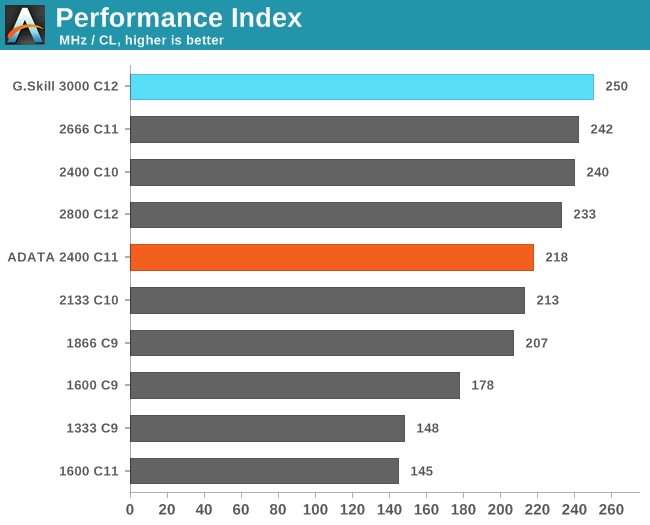
From the data in our memory overview, it was clear that any kit with a performance index of less than 200 was going to have issues on certain benchmarks. The ADATA kit has a PI of 218, which seems to be a happy medium around other kits that tend to hit either 200 or 240.
IGP Gaming
The activity cited most often for improved memory speeds is IGP gaming, and as shown in both of our tests of Crystalwell (4950HQ in CRB, 4750HQ in Clevo W740SU), Intel’s version of Haswell with the 128MB of L4 cache, having big and fast memory seems to help in almost all scenarios, especially when there is access to more and more compute units. In order to pinpoint where exactly the memory helps, we are reporting both average and minimum frame rates from the benchmarks, using the latest Intel drivers available. All benchmarks are also run at 1360x768 due to monitor limitations (and produces more relevant frame rate numbers).
Bioshock Infinite
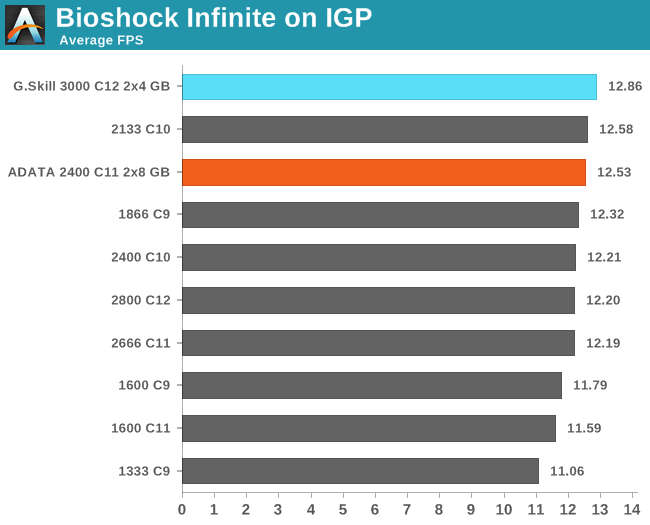
Tomb Raider
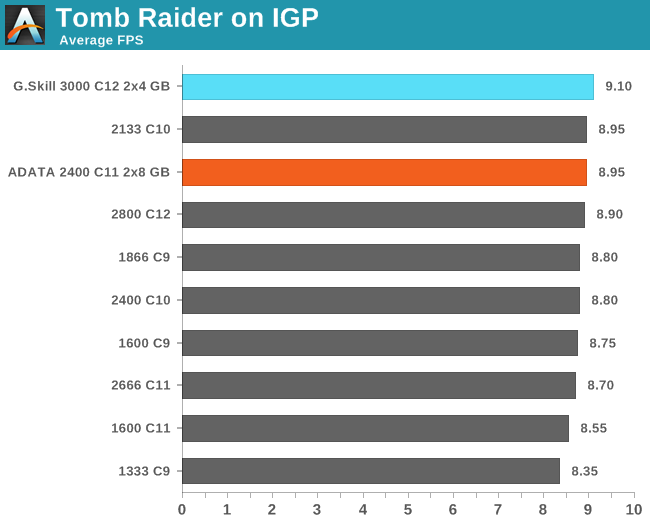
Sleeping Dogs
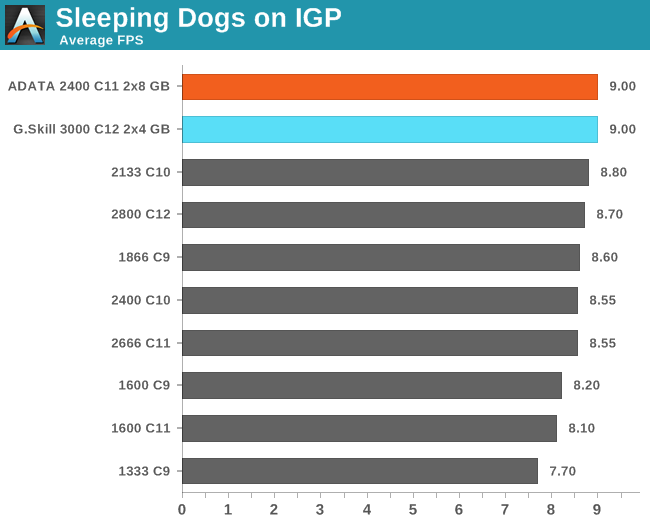
On IGP, average FPS numbers are some of the best you can get with memory, always being in the top two or three.
Single dGPU Gaming
For our single discrete GPU testing, rather than the 7970s which normally adorn my test beds (and were being used for other testing), I plumped for one of the HD 6950 cards I have. This ASUS DirectCU II card I purchased pre-flashed to 6970 specifications, giving a little more oomph. Typically discrete GPU options are not often cited as growth areas of memory testing, however we will let the results speak for themselves.
Dirt 3
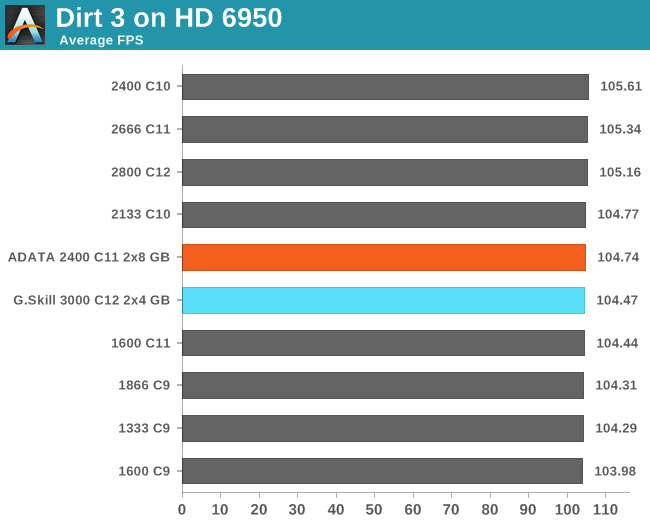
Bioshock Infinite
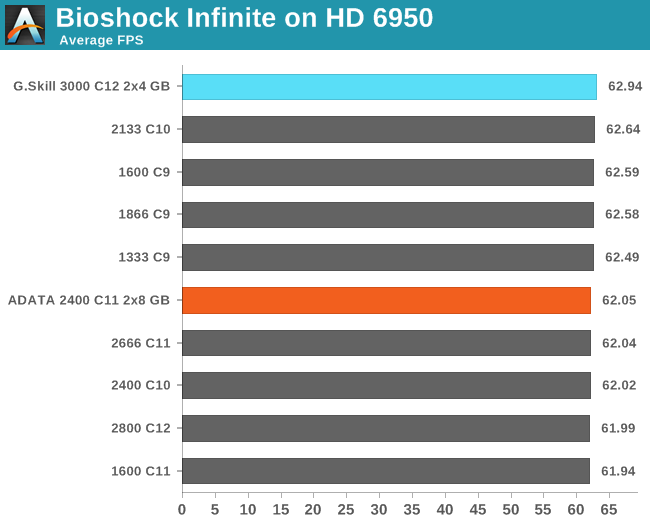
Tomb Raider
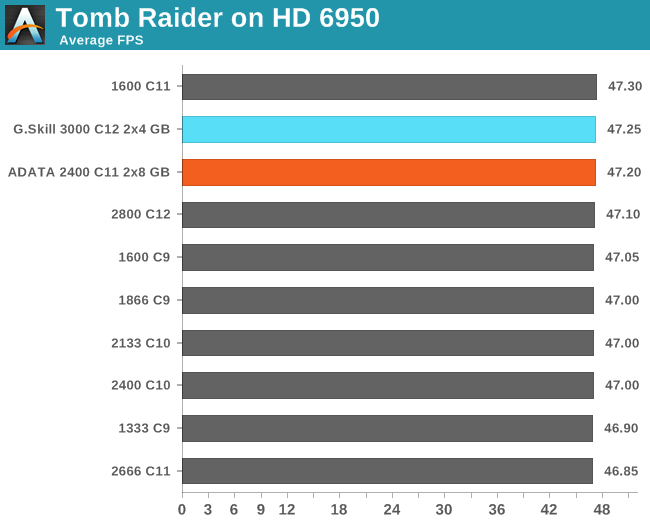
Sleeping Dogs
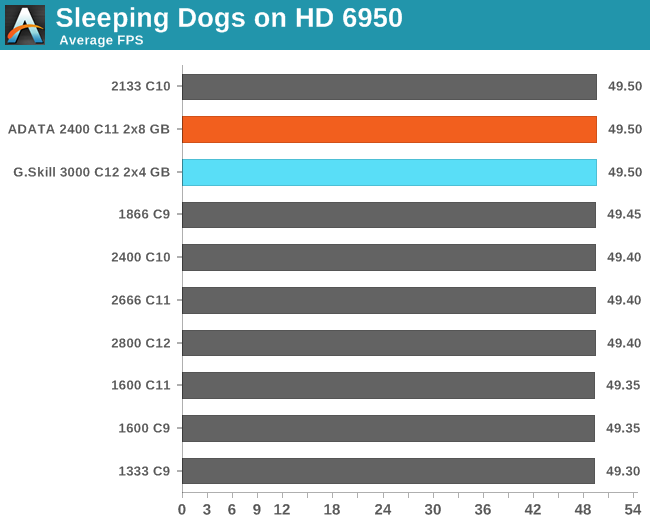
Nothing much separates any memory setting when using a single discrete GPU.
Tri-GPU CrossFireX Gaming
Our final set of GPU tests are a little more on the esoteric side, using a tri-GPU setup with a HD5970 (dual GPU) and a HD5870 in tandem. While these cards are not necessarily the newest, they do provide some interesting results – particularly when we have memory accesses being diverted to multiple GPUs (or even to multiple GPUs on the same PCB). The 5970 GPUs are clocked at 800/1000, with the 5870 at 1000/1250.
Dirt 3
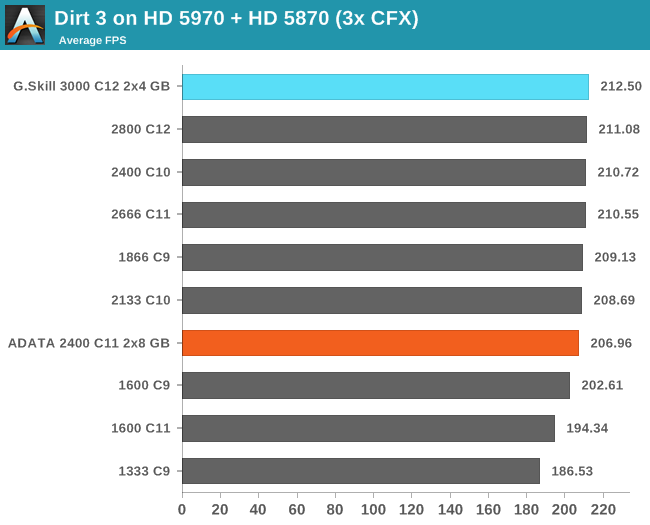
Bioshock Infinite
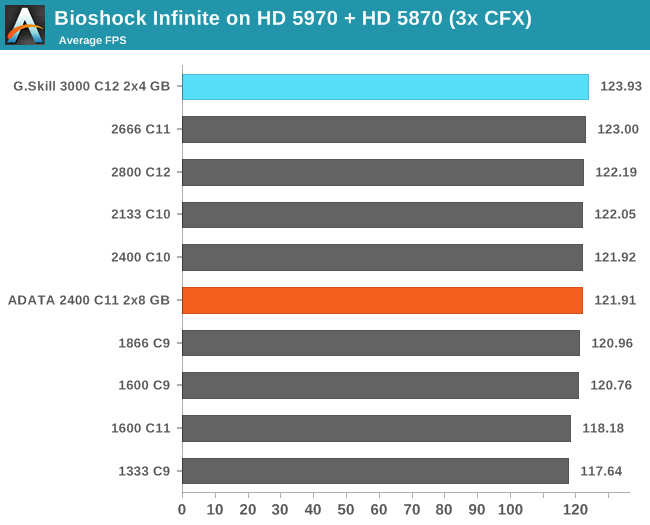
Tomb Raider
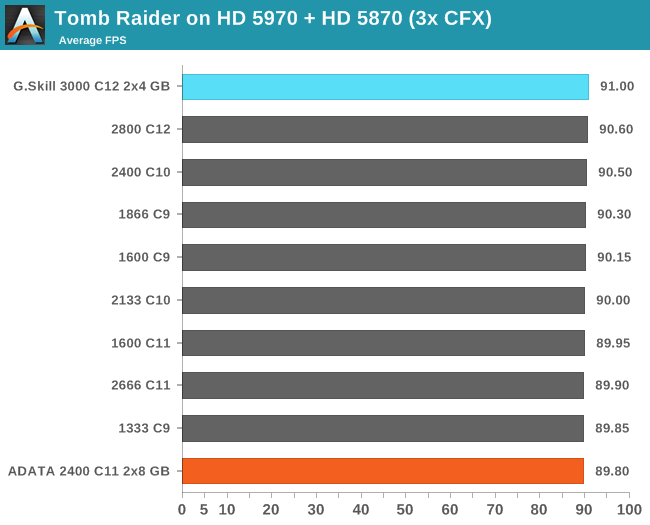
Sleeping Dogs
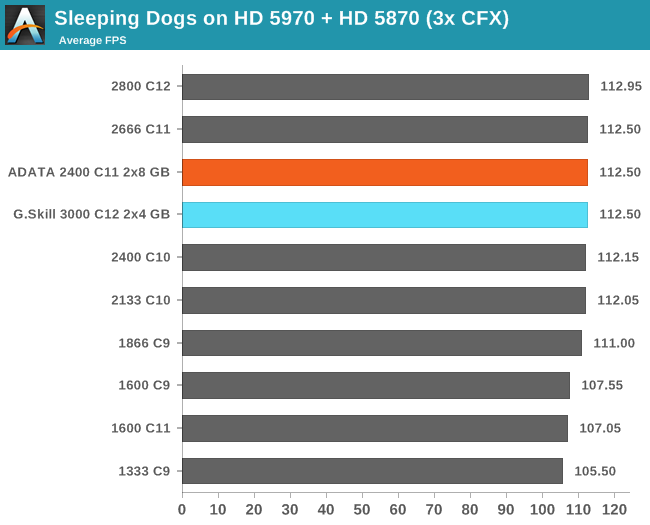
There are obvious games that benefit from high speed memory in multi-GPU configurations: Dirt 3, both in average and minimum FPS data is a prime example. Others, like Tomb Raider, offer a sub-1% difference. Sleeping Dogs seems to hit its asymptotic peak around 2133 C10.
CPU Real World
Real world testing is where users should feel the benefits of spending more on memory. A synthetic test exacerbates a specific type of loading to get peak results in terms of memory read/write and latency timings, most of which are not indicative of the pseudo random nature of real-world workloads (opening email, applying logic). There are several situations which might fall under the typical scrutiny of a real world loading, such as video conversion/video editing. It is at this point we consider if the CPU caches are too small and the system is relying on frequent memory accesses because the CPU cannot be fed with enough data. It is these circumstances where memory speed is important, and it is all down to how the video converter is programmed rather than just a carte blanche on all video converters benefitting from memory. As we will see in the IGP Compute section of this review, anything that can leverage the IGP cores can be a ripe candidate for increased memory speed.
Our tests in the CPU Real World section come from our motherboard reviews in order to emulate potential scenarios that a user may encounter.
USB 3.0 Copy Test with MaxCPU
We transfer a set size of files from the 120GB OCZ Vertex3 connected via SATA 6 Gbps on the motherboard to the 240 GB OCZ Vertex3 SSD with a SATA 6 Gbps to USB 3.0 converter via USB 3.0 using DiskBench, which monitors the time taken to transfer. The files transferred are a 9.2 GB set of 7539 files across 1011 folders – 95% of these files are small typical website files, and the rest (90% of the size) are precompiled installers. In an update to pre-Z87 testing, we also run MaxCPU to load up one of the threads during the test which improves general performance up to 15% by causing all the internal pathways to run at full speed.
Results are represented as seconds taken to complete the copy test, where lower is better.
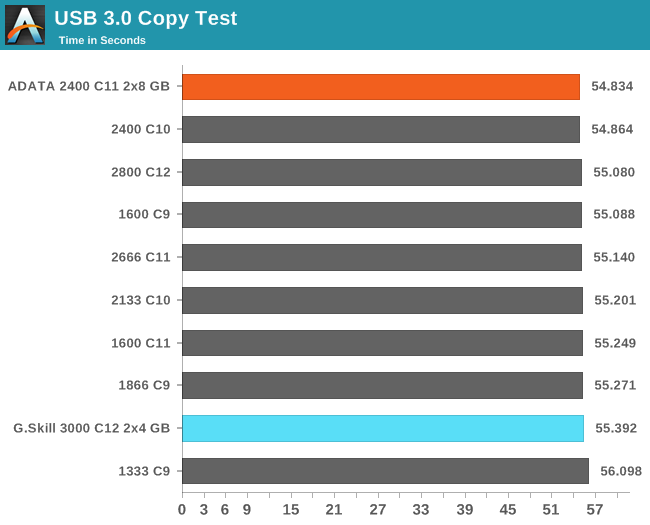
WinRAR 4.2
With 64-bit WinRAR, we compress the set of files used in the USB speed tests. WinRAR x64 3.93 attempts to use multithreading when possible, and provides as a good test for when a system has variable threaded load. WinRAR 4.2 does this a lot better! If a system has multiple speeds to invoke at different loading, the switching between those speeds will determine how well the system will do.
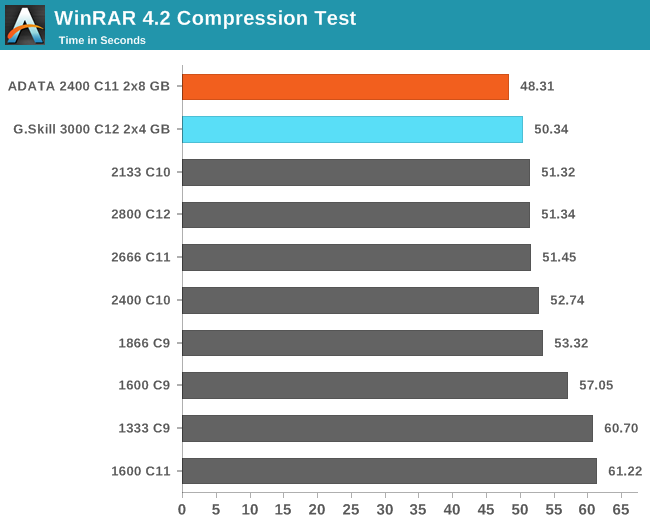
FastStone Image Viewer 4.2
FastStone Image Viewer is a free piece of software I have been using for quite a few years now. It allows quick viewing of flat images, as well as resizing, changing color depth, adding simple text or simple filters. It also has a bulk image conversion tool, which we use here. The software currently operates only in single-thread mode, which should change in later versions of the software. For this test, we convert a series of 170 files, of various resolutions, dimensions and types (of a total size of 163MB), all to the .gif format of 640x480 dimensions. Results shown are in seconds, lower is better.
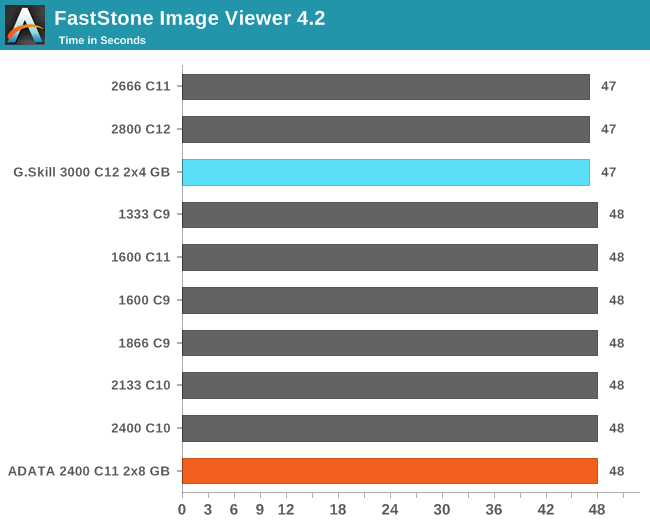
Xilisoft Video Converter 7
With XVC, users can convert any type of normal video to any compatible format for smartphones, tablets and other devices. By default, it uses all available threads on the system, and in the presence of appropriate graphics cards, can utilize CUDA for NVIDIA GPUs as well as AMD WinAPP for AMD GPUs. For this test, we use a set of 33 HD videos, each lasting 30 seconds, and convert them from 1080p to an iPod H.264 video format using just the CPU. The time taken to convert these videos gives us our result in seconds, where lower is better.
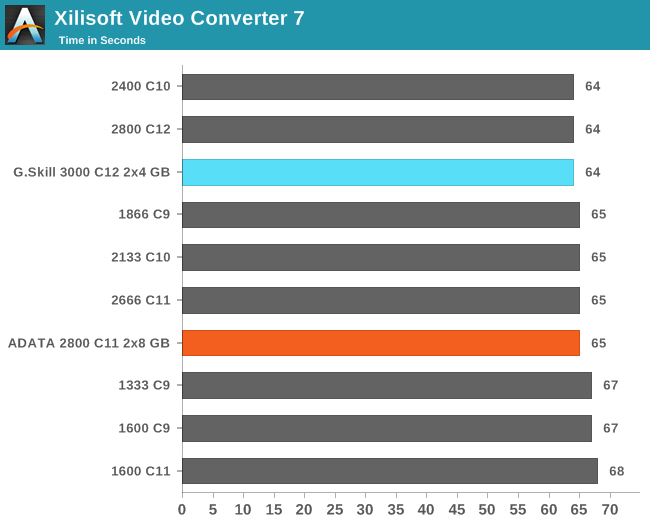
Video Conversion - x264 HD Benchmark
The x264 HD Benchmark uses a common HD encoding tool to process an HD MPEG2 source at 1280x720 at 3963 Kbps. This test represents a standardized result which can be compared across other reviews, and is dependent on both CPU power and memory speed. The benchmark performs a 2-pass encode, and the results shown are the average frame rate of each pass performed four times. Higher is better this time around.
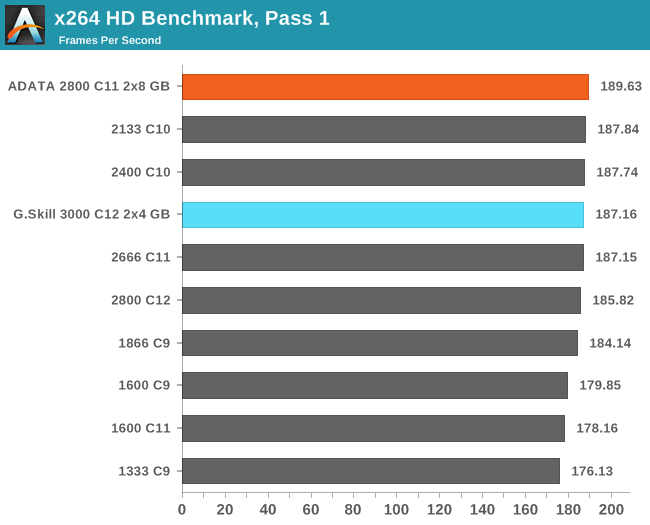
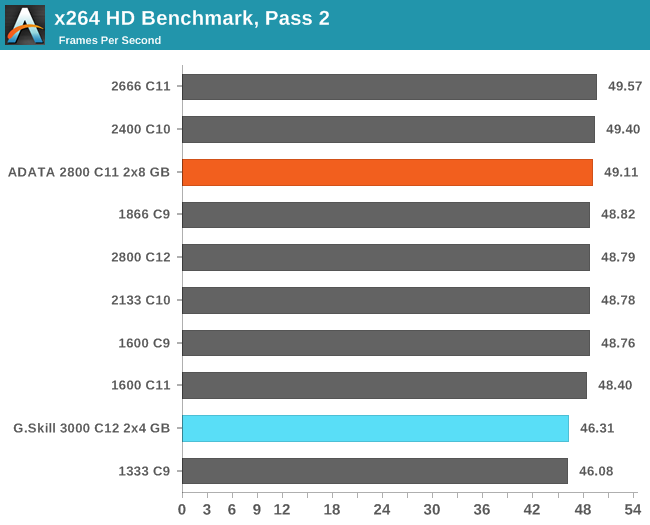
TrueCrypt v7.1a AES
One of Anand’s common CPU benchmarks is TrueCrypt, a tool designed to encrypt data on a hard-drive using a variety of algorithms. We take the program and run the benchmark mode using the fastest AES encryption protocol over a 1GB slice, calculating the speed in GB/s. Higher is better.
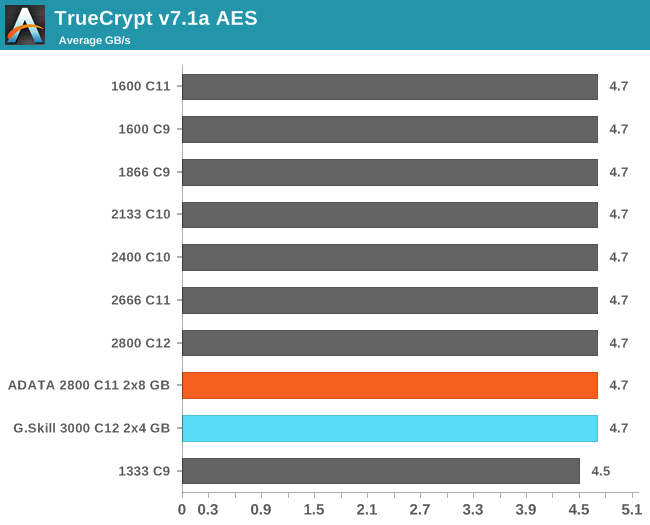
CPU Compute
One side I like to exploit on CPUs is the ability to compute and whether a variety of mathematical loads can stress the system in a way that real-world usage might not. For these benchmarks we are ones developed for testing MP servers and workstation systems back in early 2013, such as grid solvers and Brownian motion code. Please head over to the first of such reviews where the mathematics and small snippets of code are available.
3D Movement Algorithm Test
The algorithms in 3DPM employ uniform random number generation or normal distribution random number generation, and vary in various amounts of trigonometric operations, conditional statements, generation and rejection, fused operations, etc. The benchmark runs through six algorithms for a specified number of particles and steps, and calculates the speed of each algorithm, then sums them all for a final score. This is an example of a real world situation that a computational scientist may find themselves in, rather than a pure synthetic benchmark. The benchmark is also parallel between particles simulated, and we test the single thread performance as well as the multi-threaded performance. Results are expressed in millions of particles moved per second, and a higher number is better.
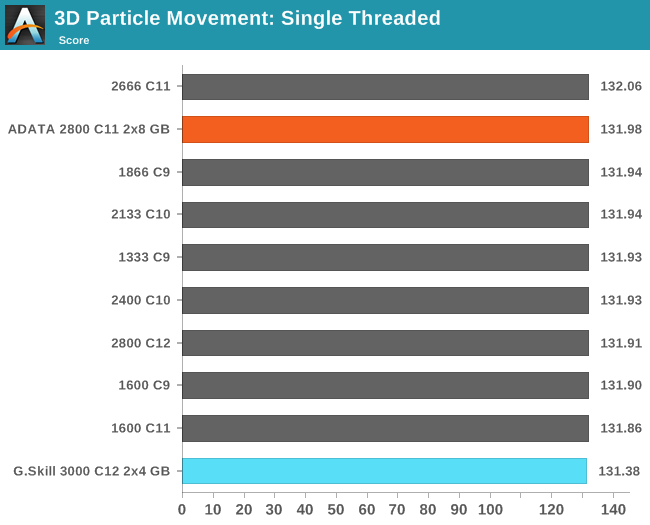
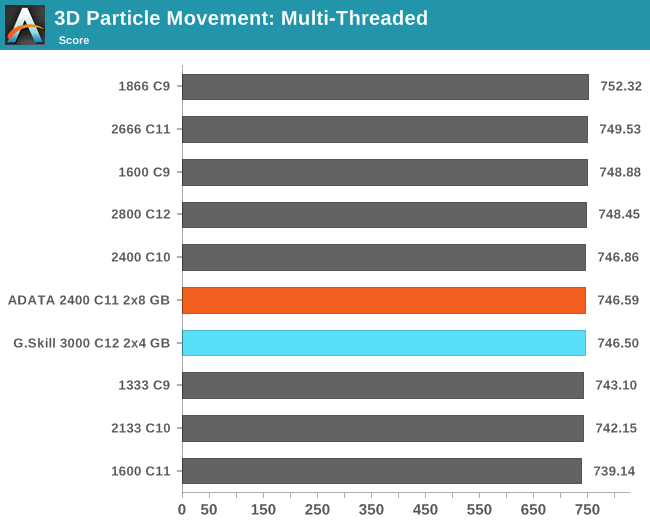
N-Body Simulation
When a series of heavy mass elements are in space, they interact with each other through the force of gravity. Thus when a star cluster forms, the interaction of every large mass with every other large mass defines the speed at which these elements approach each other. When dealing with millions and billions of stars on such a large scale, the movement of each of these stars can be simulated through the physical theorems that describe the interactions. The benchmark detects whether the processor is SSE2 or SSE4 capable, and implements the relative code. We run a simulation of 10240 particles of equal mass - the output for this code is in terms of GFLOPs, and the result recorded was the peak GFLOPs value.
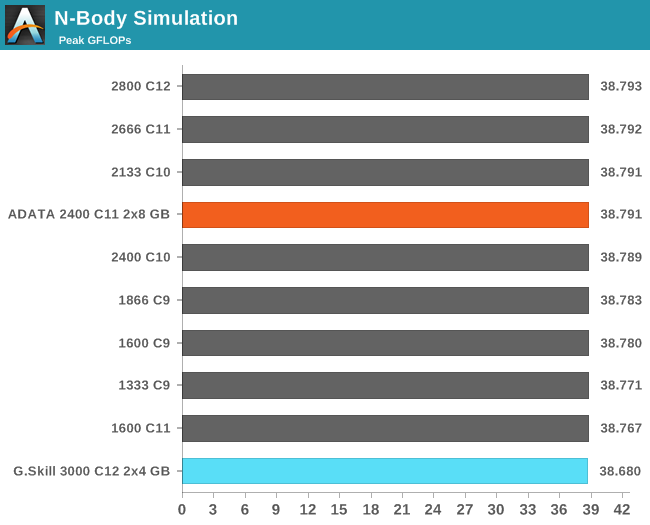
Grid Solvers - Explicit Finite Difference
For any grid of regular nodes, the simplest way to calculate the next time step is to use the values of those around it. This makes for easy mathematics and parallel simulation, as each node calculated is only dependent on the previous time step, not the nodes around it on the current calculated time step. By choosing a regular grid, we reduce the levels of memory access required for irregular grids. We test both 2D and 3D explicit finite difference simulations with 2n nodes in each dimension, using OpenMP as the threading operator in single precision. The grid is isotropic and the boundary conditions are sinks. We iterate through a series of grid sizes, and results are shown in terms of ‘million nodes per second’ where the peak value is given in the results – higher is better.
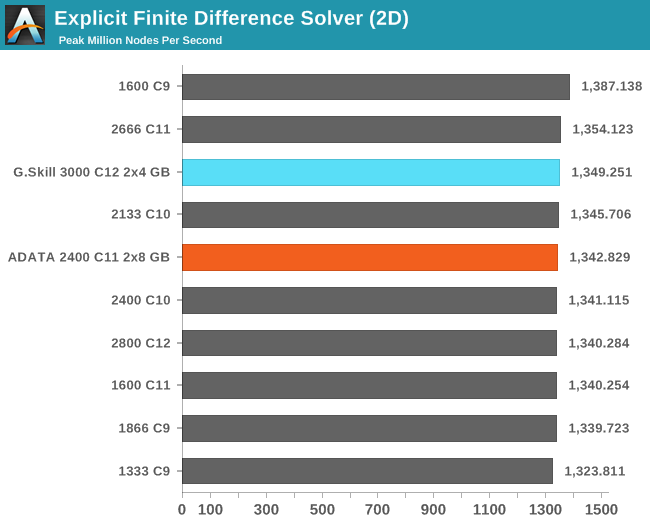
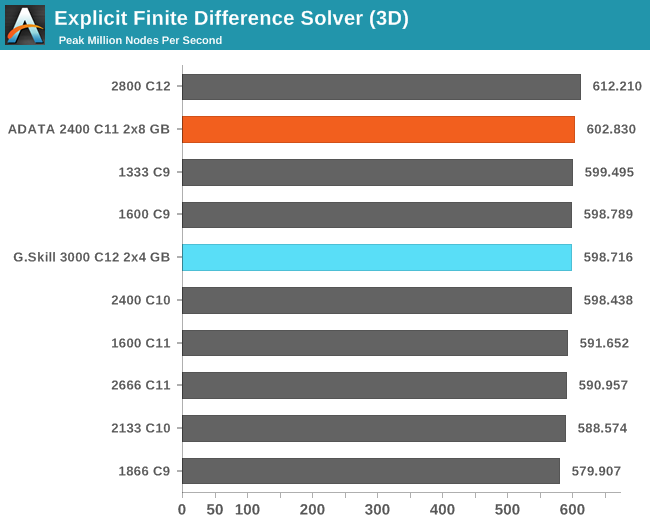
Grid Solvers - Implicit Finite Difference + Alternating Direction Implicit Method
The implicit method takes a different approach to the explicit method – instead of considering one unknown in the new time step to be calculated from known elements in the previous time step, we consider that an old point can influence several new points by way of simultaneous equations. This adds to the complexity of the simulation – the grid of nodes is solved as a series of rows and columns rather than points, reducing the parallel nature of the simulation by a dimension and drastically increasing the memory requirements of each thread. The upside, as noted above, is the less stringent stability rules related to time steps and grid spacing. For this we simulate a 2D grid of 2n nodes in each dimension, using OpenMP in single precision. Again our grid is isotropic with the boundaries acting as sinks. We iterate through a series of grid sizes, and results are shown in terms of ‘million nodes per second’ where the peak value is given in the results – higher is better.
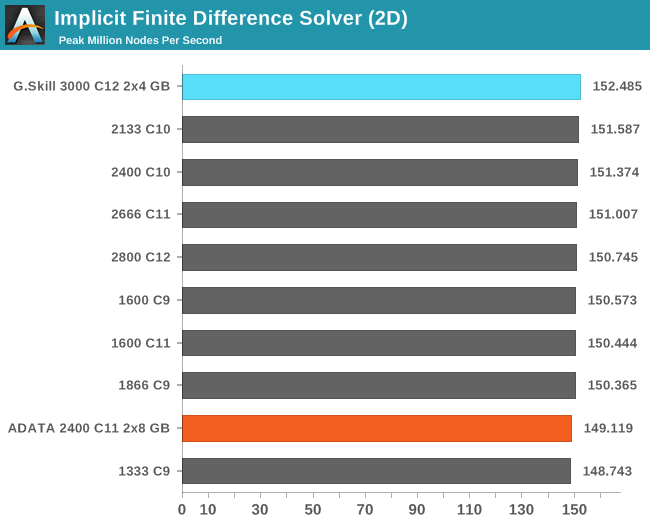
IGP Compute
One of the touted benefits of Haswell is the compute capability afforded by the IGP. For anyone using DirectCompute or C++ AMP, the compute units of the HD 4600 can be exploited as easily as any discrete GPU, although efficiency might come into question. Shown in some of the benchmarks below, it is faster for some of our computational software to run on the IGP than the CPU (particularly the highly multithreaded scenarios).
Grid Solvers - Explicit Finite Difference on IGP
As before, we test both 2D and 3D explicit finite difference simulations with 2n nodes in each dimension, using OpenMP as the threading operator in single precision. The grid is isotropic and the boundary conditions are sinks. We iterate through a series of grid sizes, and results are shown in terms of ‘million nodes per second’ where the peak value is given in the results – higher is better.
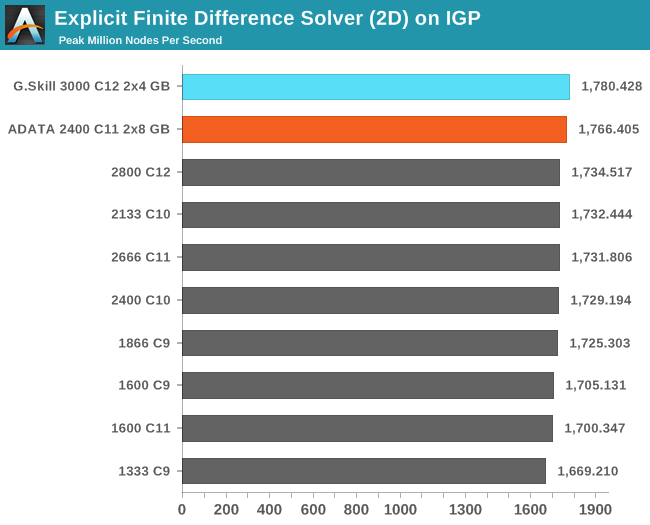
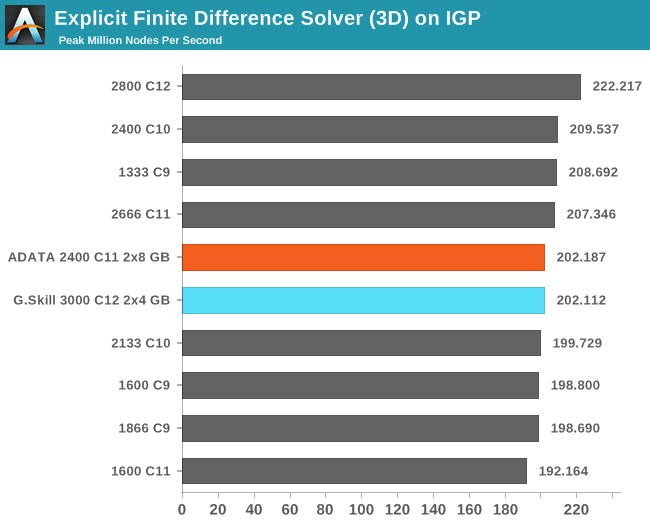
N-Body Simulation on IGP
As with the CPU compute, we run a simulation of 10240 particles of equal mass - the output for this code is in terms of GFLOPs, and the result recorded was the peak GFLOPs value.
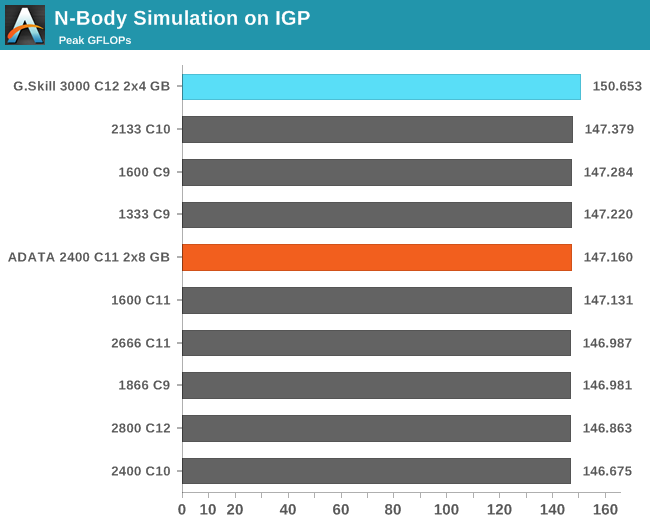
3D Particle Movement on IGP
Similar to our CPU Compute algorithm, we calculate the random motion in 3D of free particles involving random number generation and trigonometric functions. For this application we take the fastest true-3D motion algorithm and test a variety of particle densities to find the peak movement speed. Results are given in ‘million particle movements calculated per second’, and a higher number is better.
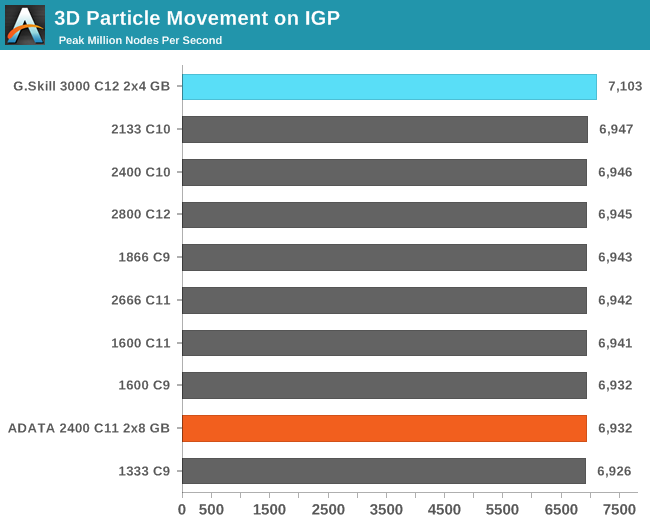
Matrix Multiplication on IGP
Matrix Multiplication occurs in a number of mathematical models, and is typically designed to avoid memory accesses where possible and optimize for a number of reads and writes depending on the registers available to each thread or batch of dispatched threads. He we have a crude MatMul implementation, and iterate through a variety of matrix sizes to find the peak speed. Results are given in terms of ‘million nodes per second’ and a higher number is better.
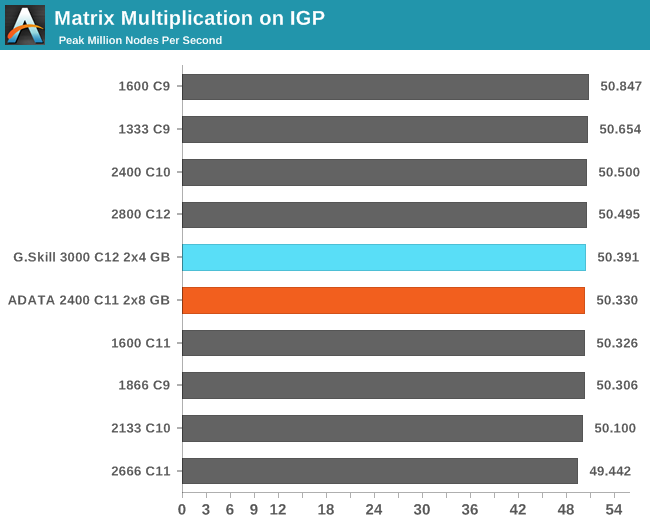
Overclocking
When it comes to memory overclocking, there are several ways to approach the issue. Typically memory overclocking is rarely required - only those attempting to run benchmarks need worry about pushing the memory to its uppermost limits. It also depends highly on the memory kits being used - memory is similar to processors in the fact that the ICs are binned to a rated speed. The higher the bin, the better the speed - however if there is a demand for lower speed memory, then the higher bin parts may be declocked to increase supply of the lower clocked component. Similarly, for the high end frequency kits, less than 1% of all ICs tested may actually hit the speed of the kit, hence the price for these kits increase exponentially.
With this in mind, there are several ways a user can approach overclocking memory. The art of overclocking memory can be as complex or as simple as the user would like - typically the dark side of memory overclocking requires deep in-depth knowledge of how memory works at a fundamental level. For the purposes of this review, we are taking overclocking in three different scenarios:
a) From XMP, adjust Command Rate from 2T to 1T
b) From XMP, increase Memory Speed strap (e.g. 1333 MHz -> 1400 -> 1600)
c) From XMP, test a range of sub-timings (e.g. 10-12-12 to 13-15-15 to 8-10-10) and find the best MHz theses are rated.
There is plenty of scope to overclock beyond this, such as adjusting voltages or the voltage of the memory controller – for the purposes of this test we raise the memory voltage to the ‘next stage’ above its rated voltage (1.35V to 1.5V, 1.5V to 1.65V, 1.65V to 1.72V). As long as a user is confident with adjusting these settings, then there is a good chance that the results here will be surpassed. There is also the fact that individual sticks of memory may perform better than the rest of the kit, or that one of the modules could be a complete dud and hold the rest of the kit back. For the purpose of this review we are seeing if the memory out of the box, and the performance of the kit as a whole, will work faster at the rated voltage.
In order to ensure that the kit is stable at the new speed, we run the Linpack test within OCCT for five minutes as well as the PovRay benchmark. This is a small but thorough test, and we understand that users may wish to stability test for longer to reassure themselves of a longer element of stability. However for the purposes of throughput, a five minute test will catch immediate errors from the overclocking of the memory.
With this in mind, the kit performed as follows:
| Test | PovRay | OCCT |
| XMP | 1608.97 | 78C |
|---|---|---|
| XMP, 2T to 1T | 1619.52 | 76C |
| 2600 11-13-13 | 1622.18 | 77C |
| 2666 11-13-13 | 1609.28 | 76C |
| 2800 11-13-13 | No Boot | No Boot |
Being able to adjust two memory strap options above XMP is actually very good showing. Other kits tested in house have trouble doing one step, let alone two.
| Subtimings | Peak MHz | PovRay | OCCT | Final PI |
| 7-9-9 | 1600 | 1618.42 | 76C | 229 |
|---|---|---|---|---|
| 8-10-10 | 1866 | 1601.58 | 77C | 233 |
| 9-11-11 | 2133 | 1610.20 | 76C | 237 |
| 10-12-12 | 2400 | 1589.52 | 77C | 240 |
| 11-13-13 | 2666 | 1616.01 | 77C | 242 |
| 12-14-14 | 2666 | 1620.62 | 77C | 222 |
| 13-15-15 | 2800 | 1608.01 | 77C | 215 |
A peak PI of 242 is a good result, showing that there is some headroom from the basic settings.
A 2400 C11 memory kit sits nicely on the performance curve. With DDR4 expected to hit within the next couple of years, buying a memory kit today might be the last DDR3 memory kit, at least on the Intel side, that you ever buy. Thus we always have to weigh up the potential benefits of faster memory between now and then against the cost.
At $200, this ADATA 2400 C11 2x8 GB kit is extraordinarily expensive, especially when everything at the same memory timings is cheaper, including the same kit but in a different color which retails for $140.
At $140, it would be at the sharp end of 2400 C11 memory kit pricing that you could buy – only a good sale would beat it. At a relative PI of 218, it sits above the 200 baseline of default kits a user should consider, but it does not set the world alight either. Through some quick and fast overclocking, it hit a PI of 242 (2666 C11), which might not show up much on the benchmarks due to the law of limiting returns.
Very few users need 16 GB right now, but it seems to be the sweet spot when it comes to memory purchasing for those who feel they need more than 8 GB, and plenty of memory manufacturers are offering these kits. Even under my heavy workload I rarely see the top side of 5GB unless I am also running everything in the background along with a game. For this reason amongst others is why no 16 GB non-ECC modules are up for grabs: the margins would be too high to invest in those ICs.
At $140 I could recommend these ADATA modules – this comes down to less than $8.75/GB. But at $200, it really is a no-go: aim for the $140 tungsten grey ones instead.
Addendum 11/19: After publishing this review, ADATA got in contact as they were confused at the high price of the Gold model against the Tungsten Grey model. I am told that the $140 value of the Tungsten Grey version of this memory is actually an internal special offer to Newegg, and that the $200 value of the Gold model is a misprint. Sounds like an expensive misprint: system builders will have a focus and it would be better to spend money on the focal point of a build. ADATA said the actual MSRP would be $180, which I pointed out is still quite high, given the price list I gave on page 2 of this review.
$180 would still put this memory at the rough end of the spectrum. ADATA took a few days, and then responded that the new MSRP for this memory would be $160. At $160, this memory is far more reasonable, and means that it sits between the G.Skill and the expensive kits, but nearer those from G.Skill.
$140 Mushkin Enhanced Blackline DDR3-2400 C11 2x8GB, Frostbyte
$148 G.Skill Ripjaws X DDR3-2400 C11 2x8GB
$152 G.Skill Ares DDR3-2400 C11 2x8GB
$155 G.Skill Sniper DDR3-2400 C11 2x8GB
$156 ADATA XPG V2.0 DDR3-2400 C11 2x8GB, Gaming (EOL)
$160 ADATA XPG V2 DDR3-2400 C11 2x8GB, Gold
$170 Silicon Power DDR3-2400 C11 2x8GB
$170 Mushkin Enhanced Blackline DDR3-2400 C11 2x8GB, Ridgeback
This also means that in a sale, they might cost even less. As of this new information about pricing, the gold kit is sold out at Newegg. Does our conclusion about the memory change? Memory has to compete primarily on price and avoiding pitfalls in benchmarks due to a bad setting. On the former, ADATA is moving in the right direction, but it still has competition. On the latter, ADATA is very much ballpark - what you might get from another kit is better (or worse) overclocking. I have two other ADATA kits in for testing, so keep abreast for those reviews soon.


